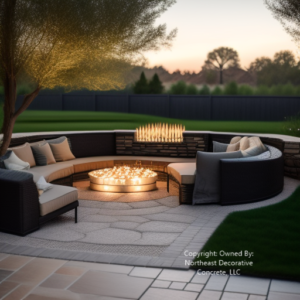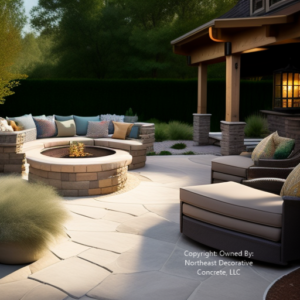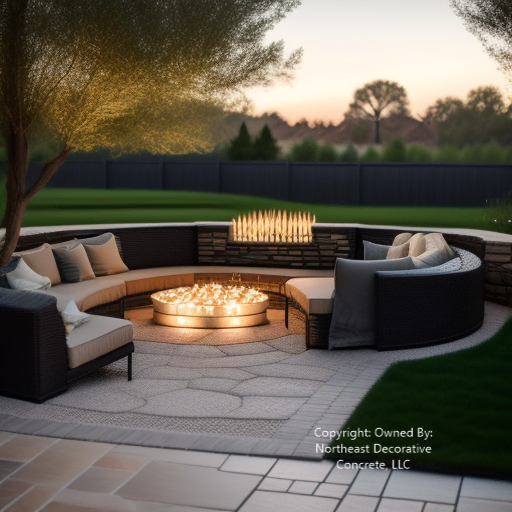
[youtube https://www.youtube.com/watch?v=2UVq2UuVzM0?rel=0&showinfo=0]
In this article, we examine the cost of stamped concrete and poured concrete to help you decide which option is more cost effective for your project.
Is Stamped Concrete Cheaper than Poured Concrete?
When it comes to cost, both stamped concrete and regular concrete have their advantages over other materials. However, stamped concrete tends to be more expensive than plain concrete due to the extra labor and materials required to create the design.
The cost of stamped concrete varies depending on the project’s size and the design’s complexity, but on average, it can be up to 20% more expensive than plain concrete.
Standard concrete costs around $12 per square foot, while a textured stamped concrete designed patio can cost up to $20 per square foot.
The cost of concrete for 2024 is estimated to be around $125 per cubic yard, with most establishments charging anywhere from $110 to $165. Grading fees may vary from $50 to $70 per hour. If you’re looking for a plain concrete slab, you’ll spend an average of $12 per square foot or from $10 to $14. This means that a 10×10 slab will cost you about $1200. The cost per yard can range from $100 to $200, with the average homeowner paying around $128. Lastly, a concrete slab usually costs about $12 per square foot.
Stamped concrete is an excellent option for those looking to make their space one-of-a-kind. Depending on the job’s complexity and local market prices, the cost can range from $10 to $20 per square foot. For a typical patio costs, you can expect to pay between $16 and $18 per square foot. Researching your options and getting a few estimates before deciding is essential. With some planning and the right contractor, you can get a beautiful stamped concrete patio that will last years.
However, when you factor in the long-term costs, concrete stamping can be more cost-effective. Textured concrete is more durable and requires less maintenance over time than regular concrete, which can last longer and save you money in the long run.
Overall, when deciding between these two options for your outdoor surface needs, you should consider not only upfront costs but also the long-term value and durability each offers to make an informed decision that best suits your needs.
What Materials are Used in Stamped Concrete and Regular Concrete Patio?
What Materials are Involved in Regular Concrete?
• Gravel
• Concrete
• Rebar or Wire Mesh
The materials involved in regular paver concrete are cement, water, aggregates (sand, gravel, or crushed stone), and admixtures (chemical additives).
What Materials are Involved in Stamped Concrete?
• Gravel
• Concrete
• Rebar or Wire Mesh
• Stamping Mats
• Pigments (Integral Color)
• Release Agent
• Concrete Sealer
Stamped concrete is a concrete surface stamped with a pattern or texture to create a decorative look. It is typically made from Portland cement, aggregate (such as sand or gravel), and water. Colorants like acid-based stains can also add color and depth to the textured surface. Additional materials, such as sealers, can also be used to enhance the appearance and durability of the finished product.

The Average Time to Install Stamped Concrete VS. Regular Concrete
How Many Days does it Typically take to Install Regular Concrete?
The time it takes to install regular concrete can vary depending on the project size and complexity, but it typically takes 1-3 days to install.
How Many Days does it Typically take to Install Stamped Concrete?
The installation time for colored concrete varies depending on the size and complexity of the project, but it typically takes 3-5 days to complete.
What is Easier to Install: Stamped Concrete or Regular Concrete Paver?
Regular concrete is generally easier to install than patterned concrete because it requires less preparation and fewer materials involved. However, installing colored concrete requires more preparation, material, and labor.
What is Involved in the Installation of Regular Concrete?
The installation of regular paver concrete typically involves the following steps:
1. Preparation of the site: This includes removing any existing debris, vegetation, and topsoil, as well as grading and leveling the area to be poured.
2. Installation of forms: Forms are used to contain and shape the concrete. Forms are usually made of wood, metal, or plastic and secured with stakes or other supports.
3. Pouring the concrete: The concrete is then poured into the form, spread evenly, to the proper concrete thickness required, and leveled out.
4. Finishing: This involves smoothing and troweling the surface of the concrete.
5. Curing: Concrete must be kept moist during the curing process to harden correctly. This is typically done by spraying the concrete with a fine water mist.
What is Involved in the Installation of Stamped Concrete?
The installation of stamped paver concrete involves the following steps:
1. Preparation: The area where the concrete will be installed needs to be adequately prepared, including leveling and compacting the soil and removing any existing grass or sod.
2. Forming: Forms are set up to contain the concrete as it is poured.
3. Pouring and Finishing: Concrete is poured, leveled, and stamped with a desired pattern.
4. Sealing: The stamped paver surface is then sealed with a sealer to protect it from the elements.
5. Finishing Touches: Any details such as coloring or saw-cutting are completed.

The Maintenance & Repair: Between Stamped Concrete and Regular Concrete
What is the Maintenance of Regular Concrete?
Regular concrete paver patio, walkway, and driveway maintenance involves regular inspection and cleaning, sealing, and patching. The routine inspection helps to identify potential problems and take corrective action before they become serious. Cleaning should be done using a hose, brush, and mild detergent to remove dirt, debris, and other contaminants. Sealing can help protect the concrete from staining and further damage. Patching may be necessary to repair damage or cracks in the concrete. Additionally, regular maintenance can help to prevent the concrete from becoming damaged by weather, wear, and decay.
What is the Maintenance of Stamped Concrete?
1. Clean regularly: Sweep and wash the colored concrete regularly to remove dirt and debris.
2. Repair cracks: Inspect the textured paver concrete for cracks. If any are found, use a concrete patch to repair them.
3. Touch up: If the patterned concrete starts to fade, use a concrete dye or pigment to touch up the colors.
4. Reseal: Reseal the stamped surface every three to five years to keep it looking its best.
FAQs:
Q: How Long Does Stamped Concrete Last?
A: Textured concrete patio paver concrete driveway can last up to 25 years with proper care and maintenance.
Q: Is Stamped Concrete Slip-Resistant?
A: Colored concrete is slip-resistant when sealed adequately with anti-slip resistance additives and maintained regularly.
Q: How Much does it Cost to Install Stamped Concrete?
A: The cost of installing patterned concrete paver driveway depends on the size and complexity of the pattern and color design, but on average, it can cost up to 20% more than plain concrete.
Q: Is Stamped Concrete More Expensive Than Poured Concrete?
A: Textured paver concrete is generally more expensive than regular concrete due to the additional labor and materials required to create the decorative pattern pave. Plain concrete is typically less costly since it is a simpler, more straightforward process.
Q: Is Stamped Concrete Cheaper than Regular Concrete?
A: Patterned concrete can be more expensive than regular concrete because it requires more labor and materials. It also involves using stamping tools to create the desired pattern or texture.
Q: What is The Disadvantages Of Stamped Concrete?
A:
- High Installation Cost: patterned concrete paver is more labor-intensive than regular concrete, so the cost for installation is often higher.
- Color Variation: paver textured concrete can fade over time and must be sealed every 3 to 5 yrs. Regular concrete doesn’t need to be filled.
- Maintenance: patterned paver concrete requires more maintenance than regular concrete, as it needs to be resealed every three to Five years.
- Chipping and Cracking: textured paver concrete is prone to chipping and cracking if not installed properly, which can be challenging to repair versus regular concrete.
Q: Is Stamped Concrete Worth the Money?
A: Stamped concrete can be a great way to add value to your home. It is a durable and long-lasting natural stone outdoor living material that will last for years. The cost of stamped concrete can vary depending on the type of project and how much you are willing to invest, but it can be an excellent value for the money.
Stamped and plain concrete are popular options for homeowners and businesses looking for stylish and durable surfaces. Regarding cost, and pros and cons, stamping is usually more expensive than regular concrete due to the extra labor and materials required to create the design. However, when you factor in the long-term costs, decorative concrete can be more cost-effective due to its strength and lower maintenance requirements. Ultimately, the best option for you will depend on your budget, project size, and design preferences.
Our Locations:
Nashua, NH
[googlemaps https://www.google.com/maps/embed?pb=!1m18!1m12!1m3!1d1498980.1443987237!2d-72.66156079829966!3d42.79478473201173!2m3!1f0!2f0!3f0!3m2!1i1024!2i768!4f13.1!3m3!1m2!1s0x89e3b66e19e2ca67%3A0x629ef75e5c12af84!2sNortheast+Decorative+Concrete%2C+LLC!5e0!3m2!1sen!2sus!4v1542255297423&w=600&h=450]North Hampton, NH
[googlemaps https://www.google.com/maps/embed?pb=!1m18!1m12!1m3!1d2990624.835237736!2d-73.07627051039219!3d42.94599081323572!2m3!1f0!2f0!3f0!3m2!1i1024!2i768!4f13.1!3m3!1m2!1s0x89e2e9d40f12774d%3A0xd5c9ce87f7a1ebdd!2sNortheast+Decorative+Concrete%2C+LLC!5e0!3m2!1sen!2sus!4v1556304554403!5m2!1sen!2sus&w=600&h=450]Concord, NH
[googlemaps https://www.google.com/maps/embed?pb=!1m18!1m12!1m3!1d2907.857843983931!2d-71.49837868460192!3d43.21247088883557!2m3!1f0!2f0!3f0!3m2!1i1024!2i768!4f13.1!3m3!1m2!1s0x89e26bd6aa8a0e0b%3A0xb332efddcca720d9!2sNortheast%20Decorative%20Concrete%2C%20LLC!5e0!3m2!1sen!2sus!4v1580238929798!5m2!1sen!2sus&w=600&h=450]

